
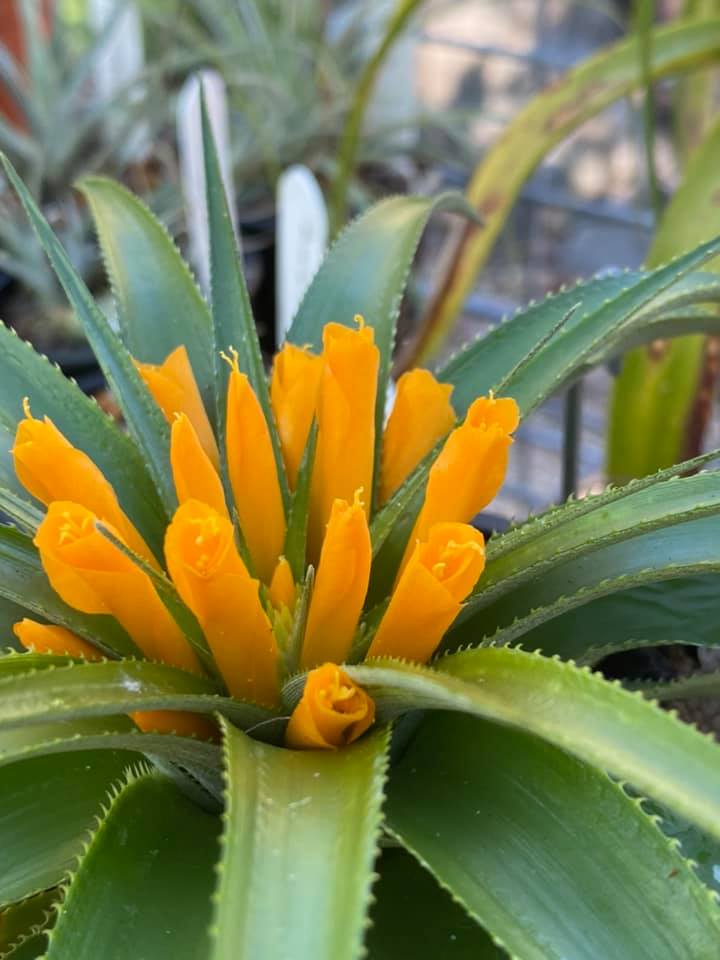
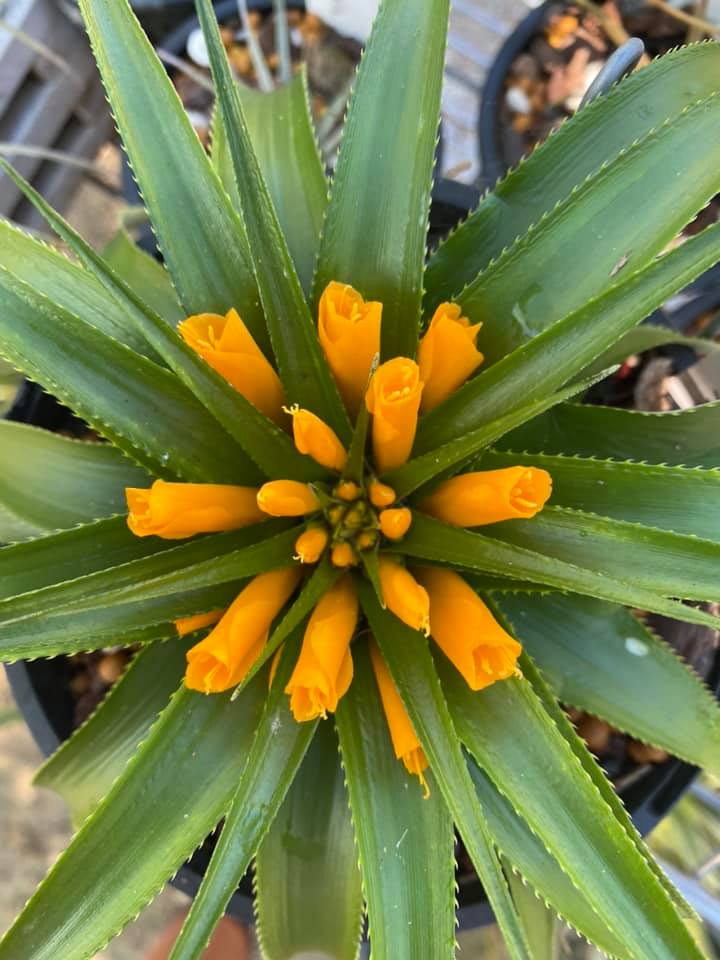
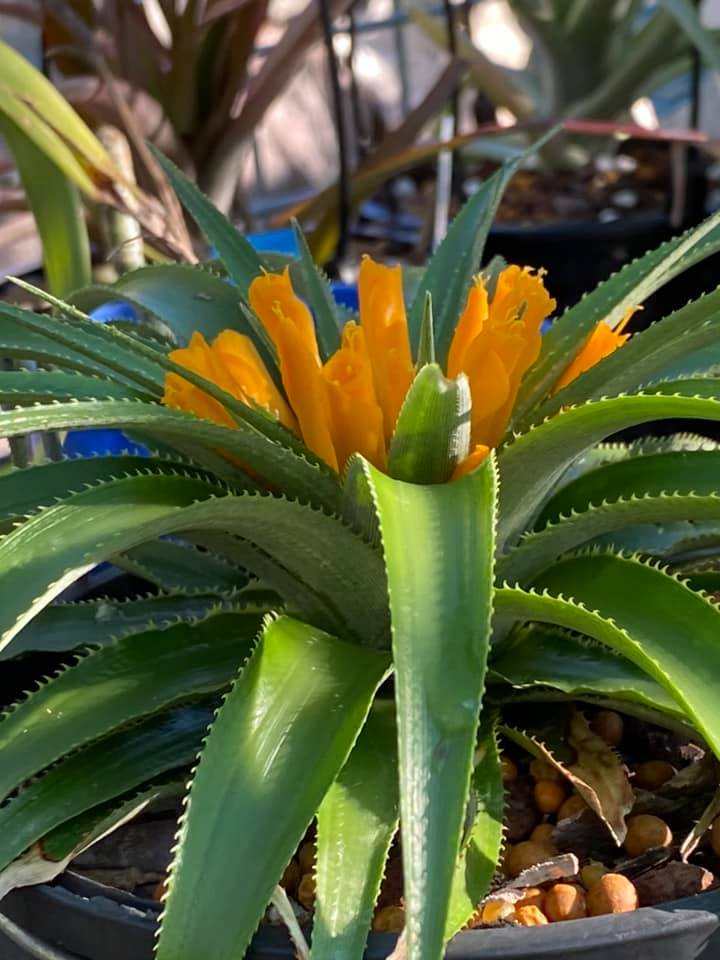


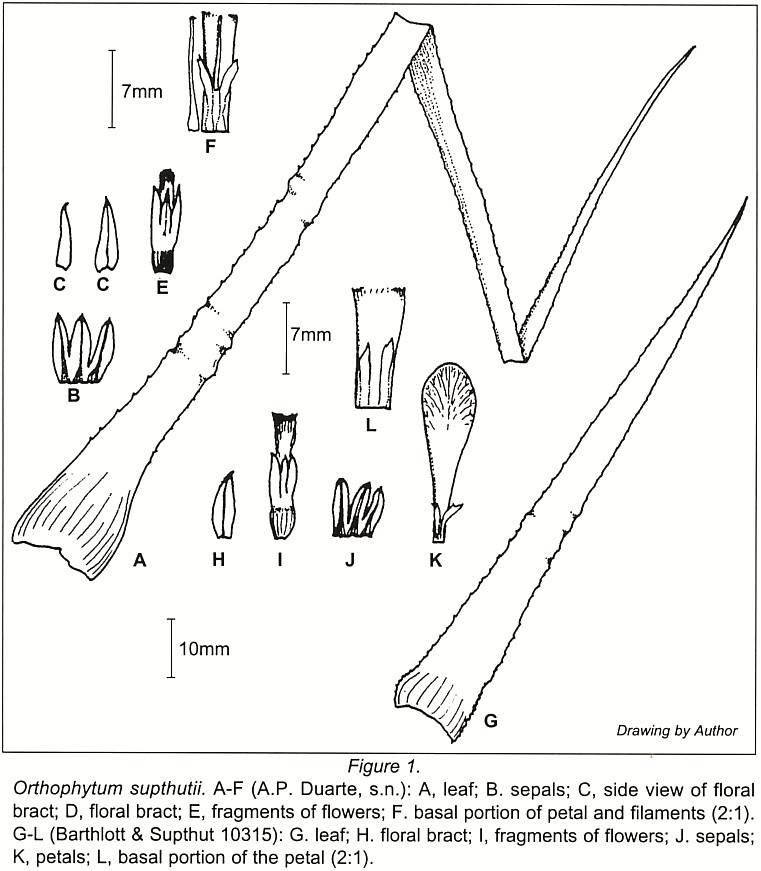

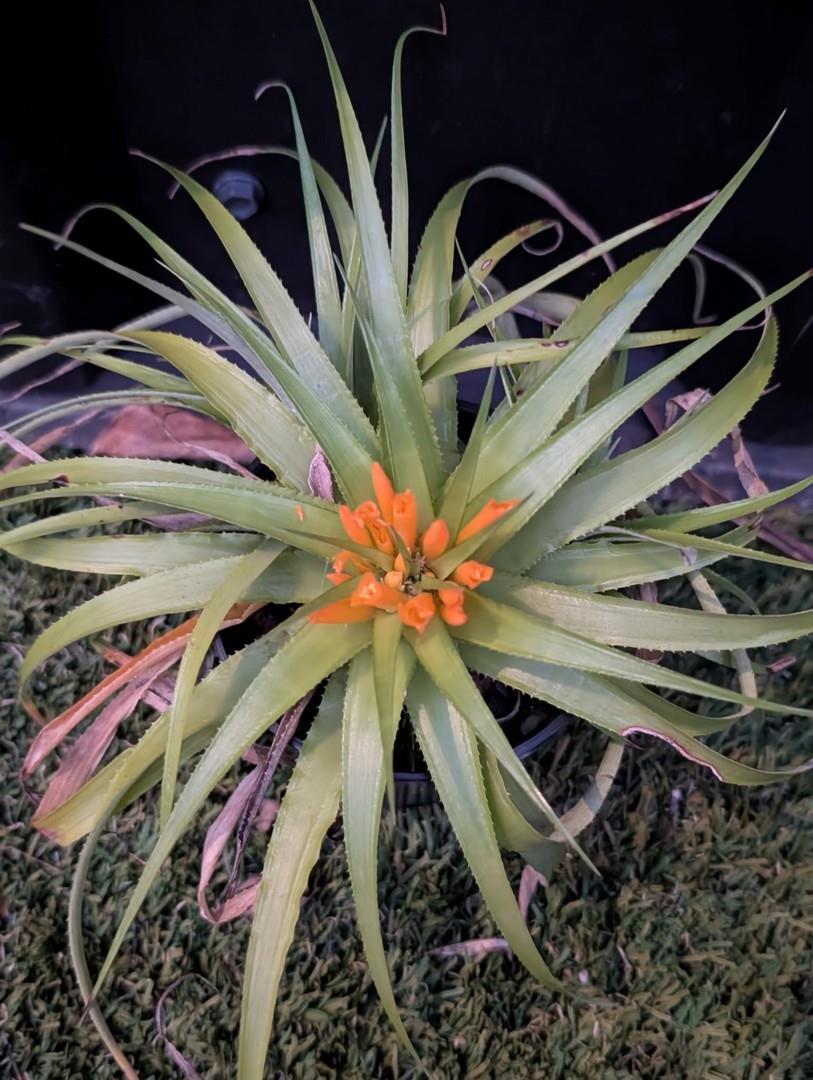
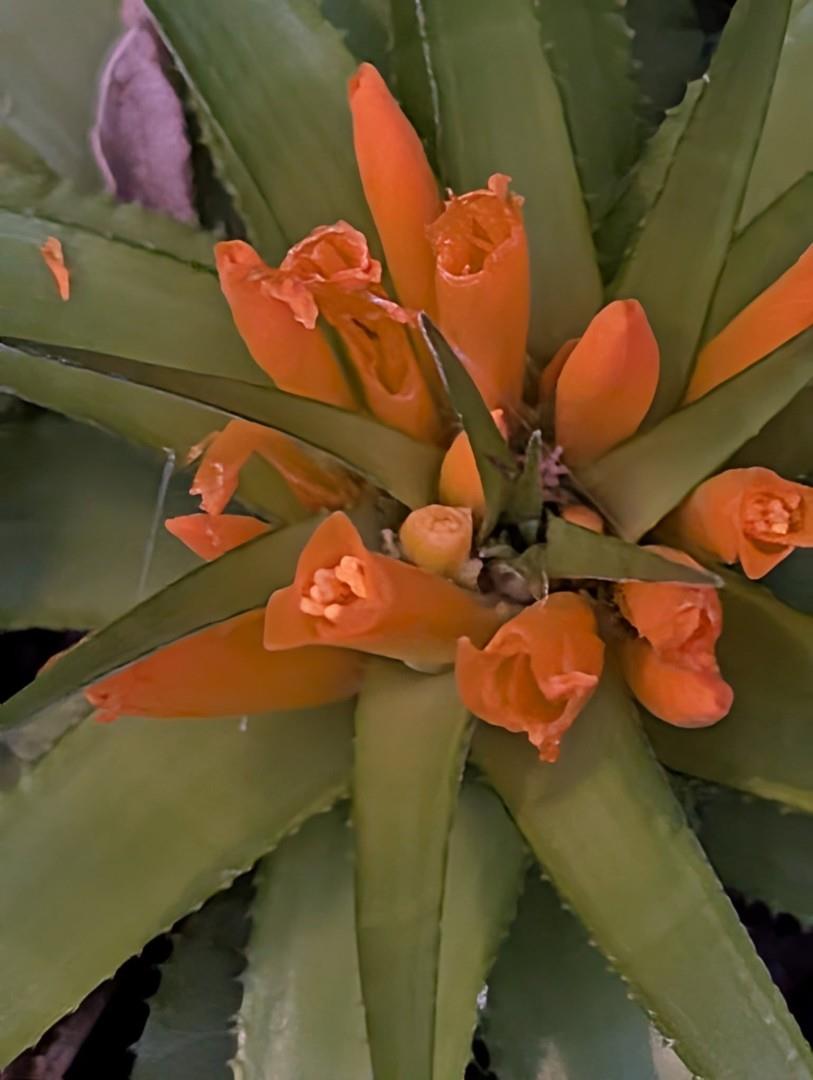
Herbs rupicolous, stoloniferous;
stem ca. 1-2 x 0.7-1 cm, short.
Leaves 5.5-25 cm long, numerous, arcuate;
leaf sheath 0.8-1.8 x 0.8-1.8 cm, green, ovate, abaxial surface lepidote, adaxial surface glabrous and lustrous, margins serrulate, prickles 0.1-0.5(-1) mm, minute;
leaf blade 5-22.5 x 0.8-1 cm, subcoriaceous, green, linear-triangular to narrowly triangular, glabrescent adaxially, densely lepidote abaxially, margins serrulate, prickles 0.3-0.6 mm, antrorse, apex acute, mucronulate.
Inflorescence compound, near 6-10(-30) flowered, primary bracts foliaceous, green, narrowly triangular, margins spinose, acute apex.
Floral bracts 1-1.3 x 0.25-0.5 cm, membranaceous, white, asymmetric, carinate, triangular margins serrulate toward the apex, apex lepidote, acute, uncinate.
Sepals 0.8-1.2 x 0.4-0.5 cm, white, asymmetric, carinate, connate, triangular, sparsely to densely lepidote toward the apex, margins entire, apex acute.
Petals 2.8-3.8 x 0.8-1.4 cm, whitish-orange at base to orange-yellow toward the apex spatulate, apex obtuse, petal appendages 0.5-1 cm, free for 0.1-0.5 cm.
Filaments of the first whorl 2.3-3.1x 0.4 cm, the ones from the second whorl 2.6-3.4 x 0.6 cm, filiform, anther 1.6-2 mm, linear, apex apiculate.
Ovary ca. 0.5 x 0.4 cm, white, ovules ca. 30 per locule, hyaline, style 3.2-4 cm, stigma lobes ca. 2 mm, weakly spreading at anthesis.
Fruit and seed not seen
Distribution - The species is known from relatively few records, all of them from areas of transitional vegetation between semideciduous seasonal forest and campo rupestre in the Serra do Cipo area. At present two populations are known from Conceicao do Mato Dentro County growing on humid quartzitic rock outcrops near semideciduous seasonal forest at 646 m altitude.
Etymology - The epithet honors the late botanist Apparicio P. Duarte, from Jardim Botanico do Rio de Janeiro (RB), who collected the type.
Additional Specimens Examined - BRAZIL. Minas Gerais. Mun. Conceicao do Mato Dentro, {fl}, Hatschbach 35400 (MBM, US); Serra do Cipo, 9 Oct 2006 {fl}, Louzada et al. 28 (SP). Santana do Riacho, {fl}, 30 Mar 1980, Menezes 941(SPF).
A New Identity for a Mysterious Species by Elton M.C. Leme, J Brom. Soc. 45(1):3-5. 1995
For almost 40 years Cryptanthus duartei L.B. Smith has been the object of speculation and mystery since it is the only species of the genus with orange-colored petals. Collected originally in 1949 in the Serra do Cipo, Minas Gerais State, by Apparicio P Duarte, the species was presented to science in 1955 being named after its discoverer. This bromeliad has never again been collected despite the intense botanical work that has been carried out in the area where it was found, today a national park.
As a mandatory step in the work of revising the Cryptanthus genus, we had the opportunity of examining the isotype of C. duartei deposited in the herbarium of the Rio de Janeiro Botanical Garden.
Although we were dealing with a dried specimen composed of fragments, it was possible to recognize the presence of two well-developed appendages at the base of its free petals, which characteristics were not observed in the original description. The fact is sufficiently relevant to alter the concept of the species, requiring a transfer to the genus Orthophytum.
When compared to species of the Orthophytum genus, Cryptanthus duartei was found to be similar to O. supthutii E. Gross & W. Barthlott, described in 1990, also collected in the Serra do Cipo, and also having orange-yellow petals. Although the original description of this species indicated some distinctions, we noted after re-examining the holotype deposited in the Herbarium Bradeanum that such differences were simply the result of faulty interpretation of identical morphological characteristics. We confirmed that observation by examining live specimens collected by the biologist Pedro I. Nahoum in the same microregion. For these reasons, we conclude that O. supthutii, which in 1990 had impressed us because of the never-before-seen color of its flowers, is not botanically different from Cryptanthus duartei.
Taking into consideration the impossibility of a new combination for Cryptanthus duartei since there is Orthophytum duartei, a distinct species also described by L.B. Smith, we must adopt the next available valid name for the species, as follows:
Orthophytum supthutii E. Gross & W. Barthlott emend. Leme & E. Gross.
Synonym: Cryptanthus duartei L.B. Smith, Smithson. Misc. Collect. 126:23, 159, fig. 67. 1955.
Plant stemless or very short caulescent, variable in size, flowering ca. 6 cm high, propagating by basal stolons.
Leaves numerous, not narrowed between sheath and blade, suberect to spreading and arched-recurving, usually forming a dense, flat rosette at anthesis;
sheaths small but distinct, broadly elliptic to suborbiculate, 1-2 cm long, ca. 1.4-2 cm wide, very densely spinulose toward apex, lustrous, glabrous;
blades very narrowly triangular, filiform-acuminate, 7-25 cm long, ca: 1 cm wide at base, flat, thin in texture, green, lustrous and glabrous adaxially, finely but distinctly nerved and very densely white lepidote abaxially, the trichomes becoming pale castaneous when dry, margins densely serrulate,
spines ca 0.5 mm long, slightly undulate in drying.
Inflorescence few to many flowered, sessile, pseudosimple to inconspicuously bipinnate;
primary bracts foliaceous;
fascicles 2-flowered;
floral bracts narrowly triangular-lanceolate, acuminate, apex curved, 6-15 mm long, 3-4 mm wide, lepidote at apex or glabrescent, membranaceous, about equaling 2/3 of the length of sepals, entire or denticulate toward apex, sharply carinate;
flowers 32-45 mm long;
sepals (7-) 11-13 mm long, ca. 3 mm wide, suboblong, symmetric, apex subacute, apiculate, and slightly recurved when dry, subcuculate, unequally connate for 2-5 mm, entire, inconspicuously lepidote to glabrescent, carinate (mainly the posterior ones), soon drying;
petals (27-) 35-40 mm long, ca. 10 mm wide near the apex, ca. 2 mm wide at base, orange-yellow, spathulate, apex obtuse, slightly exceeding the stamens, free, erect at anthesis, bearing 2 linear-lanceolate appendages at base of 5-7 mm in length, apex acuminate or irregularly bidentate, about half adnate to the petal;
stamens included;
filaments: the epipetalous ones adnate to the petals for ca. 2 mm, the episepalous free;
anthers ca. 2 mm long, fixed near 1/3 of their length about the base;
ovary ca. 5 mm long, ca. 4 mm wide, broadly obovate, subcomplanate, white, glabrous;
epigynous tube shallow;
placentae central;
ovules many, obtuse.
TYPE: Brazil. Minas Gerais: Serra do Cipo, 50 km north of Chapeu do Sol, Feb. 1988, W. Barthlott & D. Supthut 10315 (holotype HB; isotype HEID, n.v). Material examined: Minas Gerais: Serra do Cipo, Nov. 1949, A. P. Duarte s.n. (type of Cryptanthus duartei L.B. Smith) (RB, US, n.v.); ibidem, Nov. 1993, P. Nahoum s.n. (HB).
According to available information, Orthophytum supthutii is a species of restricted distribution even within the limits of its area of occurrence in the region of Serra do Cipo. For that reason, the long silence and uncertainty about its true identity should not be found strange. It grows in small populations on rocky walls at altitudes of more than 1000 meters. The plant varies somewhat in size, presenting a delicate appearance as a rule. When sterile, it resembles Orthophytum amoenum (Ule) L.B. Smith because of its size and the green and lustrous leaves. When in bloom, however, its orange-yellow petals have no equals in this genus.
Orthophytum supthutii, a Striking New Bromeliad by Elvira Gross and Wilhelm Barthlott, J Brom Soc. 40(5): 217-9. 1990
In course of a journey in February 1988 through the state of Minas Gerais, a remarkable dwarf terrestrial (epilithic) bromeliad was observed. Slides and a description of the plant were subsequently sent to Elton M.C. Leme (Rio de Janeiro), the specialist in Brazilian bromeliads. He informed us: ". . . it is really different from everything I have ever seen. As far as my knowledge is concerned, it is not closely related to any other known species because of its petal features."
On the advice of E.M.C. Leme and W. Rauh (Heidelberg), we decided to describe this new species:
Orthophytum supthutii E. Gross & W. Barthlott
Latin diagnosis Rauh & Gross, Trop. Subtrop. Pflanz. 75: 46-8., fig. 23. 1990
Plant stemless or very short caulescent, flowering up to 6 cm high, propagating by basal stolons.
Leaves numerous, forming a flat rosette of 15-20 cm in diameter.
Sheaths more or less conspicuous, membranaceous, white, glabrous, minutely serrulate, 1.5-2 cm wide, 1 cm high.
Blades small triangular, long attenuate, up to 13-15 cm long, 12 mm wide above the sheath, on the upper side glabrous, dark green, lustrous, beneath very densely white lepidote, nerved, pungent, serrulate;
teeth 2-3 mm distant one from the other, antrorse.
Inflorescence rich flowering, sunk in the center of the rosette, capitate, bipinnate.
Basal spikes in the axils of normal rosette leaves, the upper ones in the axils of smaller, subfoliate bracts, sessile, 1 cm long (without flowers), distichous, 2-flowered.
Floral bracts lanceolate, long attenuate, 10-15 mm long, membranaceous, sharply carinate, at the apex wooly, white, serrulate at the margin, shorter than the sepals; these up to 20 mm long, free, sharply carinate, glabrous, white lepidote only on the keel, membranaceous, small triangular-attenuate.
Flowers sessile.
Petals bright orange-yellow, lanceolate, 2.5-3 cm long, spathulate, very thin, 7 mm wide at the apex, spreading, at the base with two 5 mm-long fimbriate scales.
Stamens included, only the style with the three free pistils somewhat exserted.
Filaments very thin, yellow, with small, subdorsifixed anthers;
inner stamens short adnate to the petals.
Epigynous tube almost none.
Ovary flat, more or less triangular, 10 mm long, 4 mm wide.
Placentation central.
Ovules more or less numerous, obtuse.
Holotype: W. Barthlott & D. Supthut No. 10315 (=B.G.H. 70 610) (Febr. 1988), in Herb. Bradeanum, Rio de Janeiro (HB); isotype: in Herb. Inst. System. Bot. Univ. Heidelberg (HEID).
Locality and distribution: on vertical rock walls in a deciduous forest, 50 km north of Chapao do Sol, Minas Gerais, Brazil. The plants form dense mats and grow in association with Acanthostachys strobilacea and Barbacenia (Velloziaceae).
Orthophytum supthutii is a striking new species that seems to have an isolated position within the genus Orthophytum. The determination, with help of the key in L.B. Smith and R.J. Downs (Flora Neotropica 14/3, 1979), leads to O. navioides (L.B. Smith) L.B. Smith but that species is quite different from O. supthutii. The latter differs from O. navioides in the following characteristics: Leaves only 15 cm long, beneath very densely white lepidote, above green, not 30 cm long, obscurely lepidote and reddish. Inflorescence with many flowers, not few-flowering. Sepals only 2 cm long, not 3 cm. Petals bright orange-yellow, not white. Ovary up to 10 mm long, not 5 mm. Further collections must show if we have to erect an own subgenus for O. supthutii.
The plant is dedicated to D. Supthut, director of the Stadtiche sukkulentensammlung, Zurich (Switzerland), who is very interested in xerophytic bromeliads.
Cryptanthus duartei L. B. Smith, Smithson. Misc. Collect. 126: 23, 159, fig. 67. 1955.
A C. maritimo L. B. Smith, cui affinis, bracteis florigeris linearibus sepala subaequantibus, petalis aureis differt.
Desc from S&D
Plant stemless.
Leaves 35 cm long; sheaths broadly elliptic, 2 cm long, serrulate, glabrous;
blades linear-triangular, filiform-acuminate, not at all constricted at base, 12 mm wide, glabrous above, covered beneath with pale appressed scales, laxly serrulate with pale ascending teeth 0.5 mm long.
Floral bracts linear, about equaling the sepals, membranaceous, subcucullate, densely lepidote toward apex.
Sepals 13 mm long, unequally connate for 4-5 mm, oblong, broadly cuspidate-acute, subcucullate, mem¨branaceous, lepidote;
petals 4 cm long, obtuse, bright orange;
stamens and style included; ovary obconic, 5 mm long.
Type. A. P. Duarte s n (holotype US, isotype RB), on micaceous quartzite soil of rocky campo, Serra do Cipo, Minas Gerais, Brazil, Nov 1949.
Distribution. Known from the type collection only.